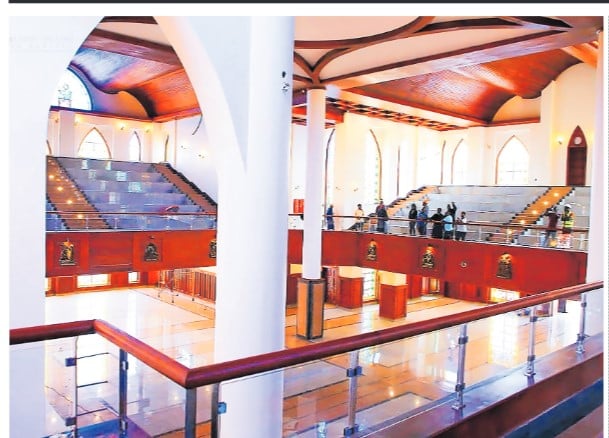Christ the King’s stunning transformation

One of the most notable upgrades is the three new galleries, which replace the small and unstable gallery of the old church that had been a source of concern for the parish whenever large crowds gathered. PHOTO/EDGAR R. BATTE
What you need to know:
- As Kampala continues to evolve Christ the King Church remains a central point in the city, not only as a place of worship but also as an architectural marvel, capturing the city’s past, present, and future in one magnificent structure
Christ the King Church, one of Kampala’s oldest and most revered places of worship, has undergone a remarkable transformation, breathing new life into the city’s skyline. With its striking new architectural design, the church now stands taller and grander than ever before, with fresh white walls contrasting beautifully with the greenery that surrounds it.
The revamped structure has become a photographic landmark, attracting not only members of the Catholic faith but also architecture enthusiasts eager to capture the beauty of its design.
The renovation project, which began in 2016, aimed to modernise and expand the church, creating more space to accommodate the growing number of believers. The original Christ the King Church, established by the Mill Hill Fathers on October 30, 1930, had become too small to comfortably hold the congregation, especially as the congregation swelled over the years. At one point, the church resorted to setting up tents to accommodate the faithful during Mass.
Monsignor Gerald Kalumba, the current parish priest, recalls that by the time he took on his role at Christ the King, the church was already struggling to keep up with the increasing demand for space.
"The church had aged, and it was clear that it was no longer sufficient for the number of people attending Mass," he says.
His predecessor, now Archbishop Paul Ssemogerere, had already laid the groundwork by constructing two new buildings; the Cardinal Wamala Hall and the Platinum building. However, much more was needed to meet the needs of the expanding congregation.
The process
"At some point, it became necessary to consider expanding the church," Monsignor Kalumba explains. "But the challenge was that with the church situated next to a busy road, it was hard for people in the tents outside to fully concentrate during Mass because of the constant noise from passing cars."
Under these circumstances, the decision was made to not just expand the existing building but to embark on a complete renovation.
This ambitious project was undertaken under the guidance of one of Uganda’s most respected architects, Henry William Ssentoogo, of Ssentoogo and Partners, Architects and Planning Consultants. Known for his work on major national projects, including the Mapeera building, the renovation of Entebbe International Airport, and the new structure at the Parliament of Uganda, Ssentoogo’s involvement brought a sense of assurance to the parish.
“He was a special man, very strict in his work ethic, and passionate about space and design,” Monsignor Kalumba recalls. “His attention to detail can be seen in the spaciousness of both the church and the accompanying offices. Sadly, he was unwell by the time the project was completed and did not live to see the church’s completion."
The plan
The initial plan was to expand the existing church, but as construction progressed, the challenges of working with the old building’s foundations became evident.
"When the architects examined the structure, they quickly realised that the original foundation could not support the plans for expansion. That’s when the idea of demolishing and rebuilding the entire church emerged," explains Monsignor Kalumba.
“At first, I was hesitant. The thought of demolishing such an important structure was daunting, but in the end, it was clear that this was the only way forward.”
The demolition of the church’s existing structures, including the parish residence and sacristy, marked the beginning of a new chapter for Christ the King. However, the project wasn’t without its financial hurdles.
"We had to rent apartments during this period, which became an unexpected financial burden," says the parish priest. "We were paying a lot of money for the two apartments, yet we still didn’t have enough to fund the actual church construction."
The project faced further setbacks when the outbreak of Covid-19 halted many church activities, further straining funds.
"When the pandemic hit, the church was empty, and the usual flow of donations was disrupted. It was a challenging time, but somehow, we managed to push through, trusting in God’s providence," Monsignor Kalumba reflects.
Despite these challenges, the new Christ the King Church stands as a testament to perseverance and faith. The redesigned structure now comfortably accommodates up to 1,300 worshippers, more than double the capacity of the original building, which had only 600 seats.
One of the most notable upgrades is the three new galleries, which replace the small and unstable gallery of the old church that had been a source of concern for the parish whenever large crowds gathered.
The new
Inside, the changes are just as striking. The altar area, which now features exquisite marble, is complemented by a new tabernacle and a stunning mosaic imported from Poland.
The image of Jesus above the tabernacle, crafted in fibreglass by Professor George William Kyeyune of Makerere University, adds a personal touch to the church’s interior. The Polish artists responsible for the mosaic even visited the church to understand the design and make sure their work complemented the overall vision.
The ceiling, too, has been redesigned, featuring a wave-like pattern that echoes the aesthetic of the original structure, adding continuity between the old and new designs. The combination of modern materials and traditional touches ensures that the church retains its historical charm while embracing a more contemporary look.
The statue of Jesus Christ, which stands proudly outside the church, was also reconstructed as part of the renovation, symbolising the renewal of the entire parish.
Monsignor Kalumba is proud of the church’s transformation and the results of the extensive renovation work.





